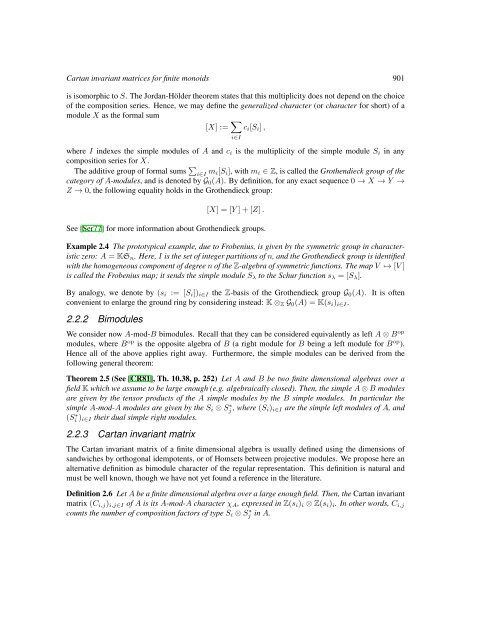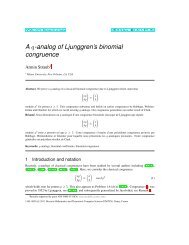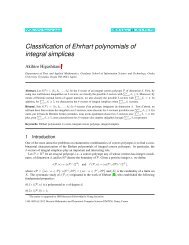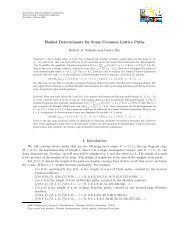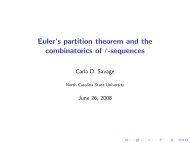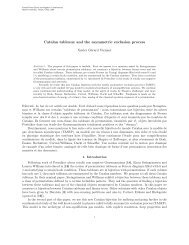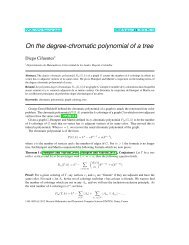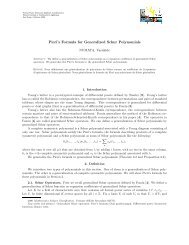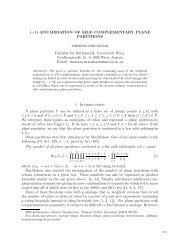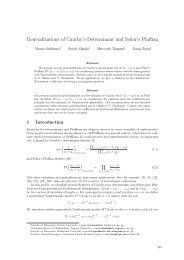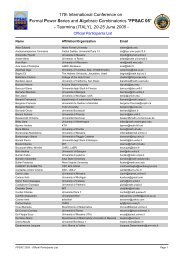Cartan invariant matrices for finite monoids - Nagoya University
Cartan invariant matrices for finite monoids - Nagoya University
Cartan invariant matrices for finite monoids - Nagoya University
Create successful ePaper yourself
Turn your PDF publications into a flip-book with our unique Google optimized e-Paper software.
<strong>Cartan</strong> <strong>invariant</strong> <strong>matrices</strong> <strong>for</strong> <strong>finite</strong> <strong>monoids</strong> 901<br />
is isomorphic to S. The Jordan-Hölder theorem states that this multiplicity does not depend on the choice<br />
of the composition series. Hence, we may define the generalized character (or character <strong>for</strong> short) of a<br />
module X as the <strong>for</strong>mal sum<br />
[X] := ∑ i∈I<br />
c i [S i ] ,<br />
where I indexes the simple modules of A and c i is the multiplicity of the simple module S i in any<br />
composition series <strong>for</strong> X.<br />
The additive group of <strong>for</strong>mal sums ∑ i∈I m i[S i ], with m i ∈ Z, is called the Grothendieck group of the<br />
category of A-modules, and is denoted by G 0 (A). By definition, <strong>for</strong> any exact sequence 0 → X → Y →<br />
Z → 0, the following equality holds in the Grothendieck group:<br />
[X] = [Y ] + [Z] .<br />
See [Ser77] <strong>for</strong> more in<strong>for</strong>mation about Grothendieck groups.<br />
Example 2.4 The prototypical example, due to Frobenius, is given by the symmetric group in characteristic<br />
zero: A = KS n . Here, I is the set of integer partitions of n, and the Grothendieck group is identified<br />
with the homogeneous component of degree n of the Z-algebra of symmetric functions. The map V ↦→ [V ]<br />
is called the Frobenius map; it sends the simple module S λ to the Schur function s λ = [S λ ].<br />
By analogy, we denote by (s i := [S i ]) i∈I the Z-basis of the Grothendieck group G 0 (A). It is often<br />
convenient to enlarge the ground ring by considering instead: K ⊗ Z G 0 (A) = K(s i ) i∈I .<br />
2.2.2 Bimodules<br />
We consider now A-mod-B bimodules. Recall that they can be considered equivalently as left A ⊗ B op<br />
modules, where B op is the opposite algebra of B (a right module <strong>for</strong> B being a left module <strong>for</strong> B op ).<br />
Hence all of the above applies right away. Furthermore, the simple modules can be derived from the<br />
following general theorem:<br />
Theorem 2.5 (See [CR81], Th. 10.38, p. 252) Let A and B be two <strong>finite</strong> dimensional algebras over a<br />
field K which we assume to be large enough (e.g. algebraically closed). Then, the simple A ⊗ B modules<br />
are given by the tensor products of the A simple modules by the B simple modules. In particular the<br />
simple A-mod-A modules are given by the S i ⊗ S ∗ j , where (S i) i∈I are the simple left modules of A, and<br />
(S ∗ i ) i∈I their dual simple right modules.<br />
2.2.3 <strong>Cartan</strong> <strong>invariant</strong> matrix<br />
The <strong>Cartan</strong> <strong>invariant</strong> matrix of a <strong>finite</strong> dimensional algebra is usually defined using the dimensions of<br />
sandwiches by orthogonal idempotents, or of Homsets between projective modules. We propose here an<br />
alternative definition as bimodule character of the regular representation. This definition is natural and<br />
must be well known, though we have not yet found a reference in the literature.<br />
Definition 2.6 Let A be a <strong>finite</strong> dimensional algebra over a large enough field. Then, the <strong>Cartan</strong> <strong>invariant</strong><br />
matrix (C i,j ) i,j∈I of A is its A-mod-A character χ A , expressed in Z(s i ) i ⊗ Z(s i ) i . In other words, C i,j<br />
counts the number of composition factors of type S i ⊗ Sj ∗ in A.


